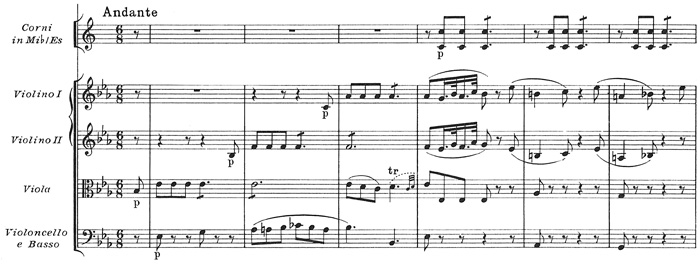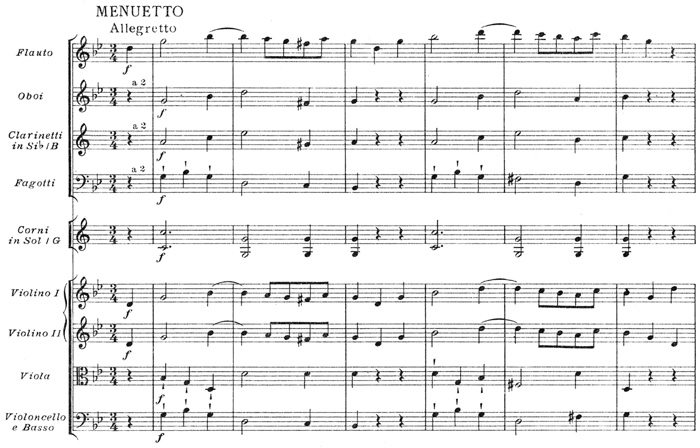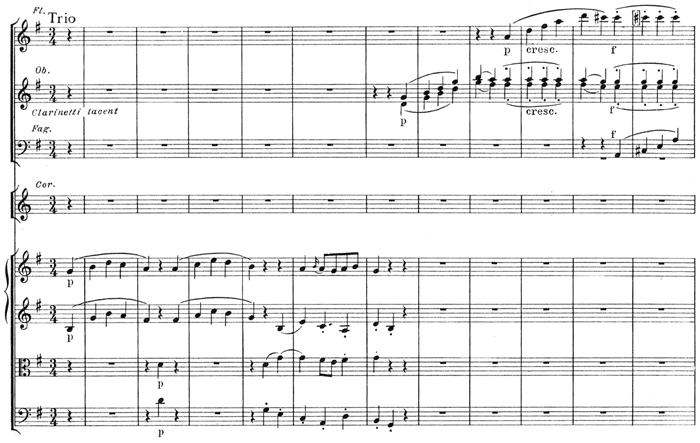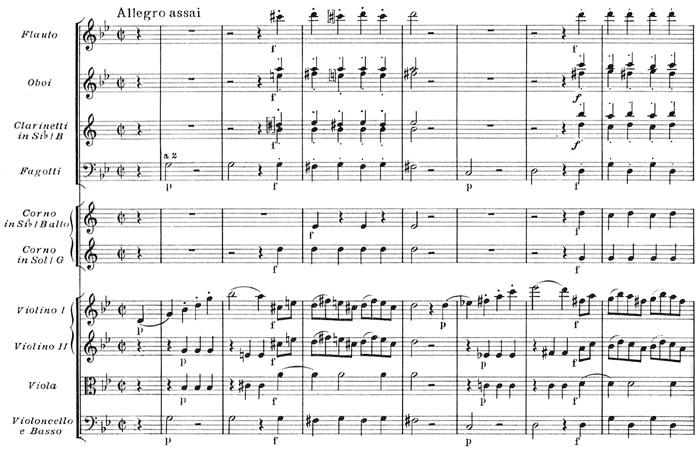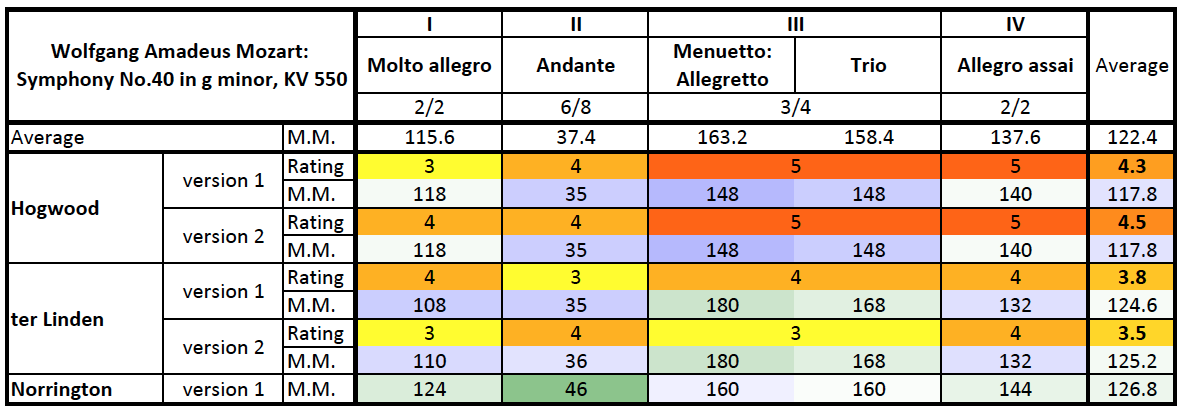Wolfgang Amadeus Mozart
Symphony No.40 in G minor, K.550
Media Review / Comparison
2014-12-09 — Original posting
2016-07-30 — Brushed up for better readability
Table of Contents
Introduction / The Recordings
This posting is about the Symphony No.40 in G minor, K.550, by Wolfgang Amadeus Mozart (1756 – 1791), of which I currently have two recordings:
- Christopher Hogwood / The Academy of Ancient Music (1983)
- Jaap ter Linden / Mozart Akademie Amsterdam (2002)
Both these recordings are recent acquisitions on CD. In my LP collection, I had the complete Mozart symphony recording with Karl Böhm (1894 – 1981), a recording of this symphony with Josef Krips (1902 – 1974), plus a (then) historically informed recording with the Collegium aureum — and I’m not particularly eager to listen to these again (maybe with the exception of the last one), especially after having heard Sir Roger Norrington with this symphony in concert…
Background, About the Composition
Wolfgang Amadeus Mozart (1756 – 1791) wrote this symphony in 1788, together with the symphony in E♭, K.543, and the symphony in C, K.551 (“Jupiter”). While we know from Mozart’s notes when these symphonies were composed, there are apparently no safe and specific records about first performances. Also the early editing history is unclear — but all these three symphonies were published only after Mozart’s death (K.550 in 1794). In the case of K.550, however, Mozart later decided to add two clarinet voices and making the appropriate changes in the oboes. It is unlikely that this happened without reason, e.g., in the form of requirements for a specific occasion. But it is unclear when these changes were made. So, we now have two valid versions of K.550:
- Flute, 2 oboes, 2 bassoons, 2 horns and strings
- Flute, 2 oboes, 2 clarinets, 2 bassoons, 2 horns and strings
Traditional performances will very likely be based on the second version, with the clarinets. Both recordings discussed in this post are from releases covering all Mozart symphonies, and both felt that the differences between the two versions are distinct enough to justify recording both versions. Note that in the second version, the Trio in the third movement is without the added clarinets.
Selecting a Version
As stated, traditional (“romantic”) interpretations will in general prefer the second version, with clarinets, for its richer sound. For historically informed performances, both versions have their specific advantages:
- the first version is likely more suited for smaller ensembles (less volume in the wind section). It may sound slightly more archaic. It’s a good fit to the dramatic, light approach taken by conductors such as Roger Norrington;
- the second version is obviously richer in sound, with more possible combinations in the wind section. But it will also typically sound softer, more rounded, maybe avoiding some of the harshness that is easier to read into version 1.
It is for good reason (other than just saving the clarinets) that Sir Roger Norrington chose the first version for hist concert in Zurich on 2014-11-25.
Mozart and Minor Keys
He also gave a brief introduction, pointing out that Mozart only wrote two symphonies in A minor key, both actually in G minor, the first (“small”) G minor symphony K.183, and K.550. Norrington pointed out that also from all the piano concertos, only two are in minor keys (D minor in K.466, C minor in K.491).
He also pointed out that Mozart chose G minor in very specific places in his oeuvre, associated with despair (such as in Tamino’s aria in the opera “Die Zauberflöte”). And so he infers that also this symphony ought to be seen as expressing desperation, tragedy, the dark side of the human fate. He sees this symphony as being much more than the moody, light tune that everybody knows, and which is omnipresent in warehouses, escalators, maybe even restaurants. In fact, the common perception of this symphony is so overused that K.550 (at least in my view) has its lengths, is maybe even boring at times. Norrington certainly proves that this piece can be very emote, unsettling (and fresh again!).
The Movements
The Symphony No.40 in G minor, K.550 has four movements (the score samples are from the second version). In the brief description below I mention Norrington’s view — not necessarily as the ultimate reference (though I personally am close to seeing his interpretation this way), but more because I’m otherwise not discussing
I. Molto Allegro (2/2)
299 bars, no repeats
The movement starts with the following, all-too-known main theme in the strings:As Sir Roger Norrington points out, this is Molto allegro (i.e., pretty fast) and alla breve. If one plays half notes at Molto allegro pace, the music is substantially faster than people commonly expect. In concert, Norrington played this movement at about 1/2 = 124. For additional comments see also my concert review.
II. Andante (6/8)
52 + 71 bars, both parts repeated
This is typically heard as a (mostly) bucolic, slow movement — sort of a fast Andante with 1/8 = 100 – 110:
However, as Sir Roger Norrington keeps pointing out, 6/8 means two beats per bar, i.e., 2 x 3/8 — and with this, an Andante is much faster: in concert, Norrington played this at around 3/8 = 46 (as opposed to 3/8 = 35 with the common expectation!), and with this, the movement becomes restless, menacing, “dangerous”, a good fit for the first movement!
III. Menuetto: Allegretto (3/4) — Trio (3/4) — Menuetto da capo
Menuetto: 14 + 28 bars, both parts repeated; Trio: 18 + 24 bars, both parts repeated
As an Allegretto, this movement should be played slower than Allegro, i.e., it is not a lightweight, Viennese waltz that some may expect when they see 3/4! One should also note the many marcato marks (vertical bars in Mozart’s notation) in the score. This also points towards a rather heavy pace; in concert, Norrington played this at around 1/4 = 160, a rather heavy, earnest movement, overall:
The Trio, conversely, is in G major, played without clarinet also in the second version, a serene, peaceful intermezzo (same tempo as the Menuetto):
But that serenity remains an episode, as the serious atmosphere of the Menuetto soon returns.
IV. Allegro assai (2/2)
124 + 184 bars, both parts repeated
The last movement is virtuosic, but again not just lightweight. It is a in the form of a sonata movement; from that point-of-view, some conductors (e.g., Jaap ter Linden) will prefer not to repeat the second part.
With historically informed playing, the peak notes in the first violin (played without vibrato) have a tendency to sound rather sharp, sometimes almost painful. One could soften this with vibrato, but I guess we must assume that the “sharp” effect is intended. In concert, Norrington played this at around 1/2 = 144 (with both repeats).
The Interpretations, Overview
Both recordings below are historically informed and were recorded on period instruments (in the aforementioned concert, Sir Roger Norrington had this played on modern instruments). In order to provide an overview for my ratings and for the metronome values (M.M.), I have created a little table (Norrington was not rated, as I don’t want to compare CD recordings with live concert experiences):
The metronome values (M.M.) are approximate; for the movements I and IV, they are based on 1/2, for movement II on 3/8, for movement III on 1/4. The ratings are subjective and my personal views.
The Interpretations, Detail
Christopher Hogwood / The Academy of Ancient Music
Mozart: The Symphonies
Christopher Hogwood / The Academy of Ancient Music
Decca / L’oiseau-lyre 452 496-2 (19 CDs, stereo); ℗ 1979 – 1986 / © 1997
Booklet: 127 pp. e/f/d/i

In the years 1978 – 1985, Christopher Hogwood and The Academy of Ancient Music with concert master Jaap Schroeder (1925 – 2020) recorded all Mozart symphonies. For general information & remarks see the post “Mozart: Symphony in D major, K.19“. Compared to K.19, I like the sound of these interpretations much more. The dry acoustics help keeping the sound transparent, and I also suspect that the microphones were placed better in these recordings, as they sound more spread, spatially. Hogwood appears not quite as strict towards the use of vibrato as Jaap ter Linden or Norrington: “critical” peak notes (such as in the slow movement, or in the Finale) appear a tad softened, even though the vibrato remains inconspicuous, hardly noticeable.
Notes on the Movements
I. Molto Allegro (2/2)
version 1: 7’01” — version 2: 6’58”
After having heard Norrington’s interpretation, this sounds too dance-like, light-weight, sometimes even cheerful. The articulation sometimes tends towards legato, could be lighter. Occasionally, the articulation is slightly superficial. I have a slight preference for version 2 in this case: here, the broader articulation matches the richer sound with the added clarinets.
II. Andante (6/8)
version 1: 14’08” — version 2: 14’22”; both parts repeated
Played as 3/8, not as 6/8 (with 2 x 3/8), 6 beats per bar. At least, with version 1, the movement exhibits some hard contours, showing the tragic aspects of this movement. Version 2 sounds softer, more rounded, and is maybe affected more by the (too) slow tempo. At this pace, the movement starts to sound long.
III. Menuetto: Allegretto (3/4) — Trio (3/4) — Menuetto da capo
version 1: 5’23” — version 2: 5’20”; all repeats played, even in the da capo
A good tempo, shares the heavy, almost clumsy character also found in Norrington’s interpretation. Hogwood does all repeats, even in the da capo section; some might find this excessive. But it’s still the shortest movement, after all, even with all these repeats.
IV. Allegro assai (2/2)
version 1: 9’08” — version 2: 9’04”; both parts repeated
Good articulation and coordination, good tempo as well! Part 2 (development and recapitulation sections in the sonata movement) is repeated as well.
| Overall Duration: | 35’37“ (version 1) — 35’41“ (version 2) |
| Rating: | version 1: 4.3 (3 / 4 / 5 / 5) — version 2: 4.5 (4 / 4 / 5 / 5) |
| Recommendation: | A good interpretation. I prefer it over Jaap ter Linden’s (and with Hogwood, I have a slight preference for the second version, with the clarinets). It’s now over 30 years old, so maybe the time wasn’t ready yet for Norrington’s tempo? If Norrington were to make a studio recording, I’m sure that this would win hands down over both these recordings, particularly in the first two movements. |
Jaap ter Linden / Mozart Akademie Amsterdam
Mozart: Complete Symphonies
Jaap ter Linden / Mozart Akademie Amsterdam
Brilliant classics 94295 (11 CDs, stereo); © 2011
Booklet: 23 pp. English

This is the more recent recording, made in 2001 / 2002, released in 2011: Jaap ter Linden and the Mozart Akademie Amsterdam; for general information & remarks see the post “Mozart: Symphony in D major, K.19“. In contrast to what I stated for Hogwood’s recordings: in the case of Jaap ter Linden, the recordings of this late symphony sound bulky, almost massive (for K.19, the warm acoustics supported the small ensemble). Here, the acoustics are rather detrimental to the transparency, and they cover a lot of detail in the articulation, and the strings tend to drown in the sound of the wind instruments — too bad!
Notes on the Movements
I. Molto Allegro (2/2)
version 1: 7’31” — version 2: 7’29”
Played alla breve, but rather slow for a Molto allegro! On top of that, the velvety, overacoustic sound further softens the music, making it lack transparency and clarity. In version 2, the sound is even thicker, denser, making the music sound soft and heavy. Lacks the atmosphere of despair that Norrington is seeking in this music.
II. Andante (6/8)
version 1: 10’01” — version 2: 9’53”; second part not repeated
The same slow tempo as Hogwood (not really 6/8). On top of that, there are moments when Jaap ter Linden appears to lose tempo control, the music “runs away” very slightly. This could also be the result from combining takes from different sessions, but this should definitely not happen. The sound is dull, the strings too weak; even though the articulation is careful and detailed, the overall impression is dominated by the sound of the recording. Version 2 is very slightly faster. But also has some issues with tempo control (mostly towards the end), like the first version. But in either case, this sounds like a bucolic, peaceful piece. This doesn’t really fit into a tragic Mozart symphony in G minor. At this slow pace, it is understandable that Jaap ter Linden omits the second repeat.
III. Menuetto: Allegretto (3/4) — Trio (3/4) — Menuetto da capo
version 1: 3’45” — version 2: 3’50”; no repeats in the da capo
Too bad Jaap ter Linden stuck with the traditional model for this movement. This is as fast as a light Viennese waltz: too fast, and also too soft. Mozart’s marcato indications are hardly observed. “Historically informed” can sometimes also mean taking a slower tempo than what the traditional / romantic perception expects! With that fast tempo, it is understandable that the conductor takes the Trio at a slightly slower pace — though there is no indication to this effect in the score. And the trio still sounds pushed. Plus, the return to the Menuetto da capo at the original tempo is not entirely harmonic.
IV. Allegro assai (2/2)
version 1: 6’51” — version 2: 7’03”; second part not repeated
Also this movement suffers from the dull sound of the recording. And for an Allegro assai, the tempo is at the lower limit. Yet, there are occasional instabilities / strange, sudden tempo changes also here (not clear to me whether that is from combining takes from different sections). Part 2 is not repeated. But that is acceptable with a sonata movement.
| Overall Duration: | 28’07“ (version 1) — 28’07“ (version 2) |
| Rating: | version 1: 3.8 (4 / 3 / 4 / 4) — version 2: 3.5 (3 / 4 / 3 / 4) |
| Recommendation: | I’m not over-excited. Unlike with K.19, here I prefer Hogwood. What really defeats this interpretation is the sound quality, and the traditional tempo concept. Version 1 has a slight advantage, as the lighter instrumentation fares slightly better in this acoustic environment. |
Addendum
As mentioned above, Mozart’s Symphony in G minor, K.550 was featured in a concert at the Tonhalle in Zurich, on 2014-11-25, with Sir Roger Norrington and the Zurich Chamber Orchestra. See my concert review for Bachtrack.com. As this is in German, I have written up a separate, more extended review in the posting “Norrington & Albrecht Mayer in Zurich, 2014-11-25“.



